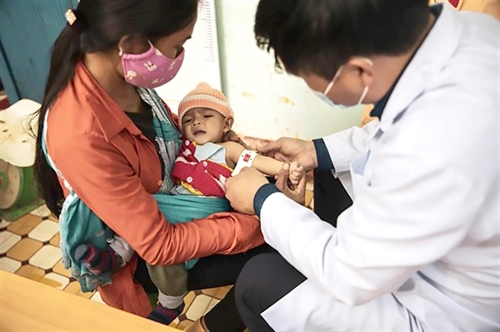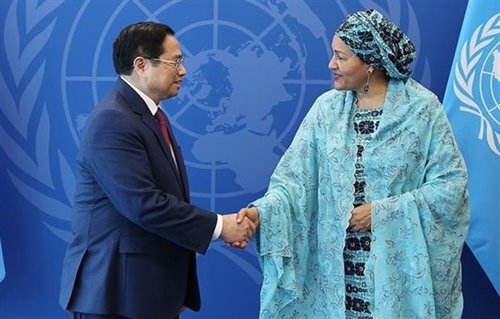UNICEF Vietnam calls for the inclusion of treatment for child wasting into the domestic health examination and treatment law and other long-term development funding schemes to help save the lives of many children in the country.
Child wasting refers to the most lethal form of undernutrition and one of the top threats to child survival. Around one in five deaths among children under 5 are attributed to severe wasting, which is caused by a lack of nutritious food and repeated bouts of diseases such as diarrhea, measles and malaria, which in turn compromise a child’s immunity.
 |
| UNICEF Vietnam calls for the inclusion of treatment for child wasting into the domestic health examination and treatment law__Photo: VNA |
UNICEF continues to release global evidence on the rising levels of malnutrition in children. All forms of this disease are prevalent in Vietnam, where the estimate based on 2019 annual nutrition surveillance revealed that 230,000 under-5 children suffer from severe acute malnutrition (SAM) annually.
Malnutrition is listed as a disease in the World Health Organization's (WHO) International Classification of Diseases, and it is a preventable and treatable disease. Wasting, defined as low weight-for-height, is the most visible and lethal type of malnutrition.
Severe wasting, where children are too thin for their height resulting in weakened immune systems, is the most immediate, visible and life-threatening form of malnutrition. Worldwide, at least 13.6 million children under 5 suffer from severe wasting, resulting in one in five deaths among this age group.
Given the close links between SAM, stunting and mortality, interventions aimed at the prevention and treatment of SAM will help to reduce both child mortality and stunting further.
Vietnam has prioritized nutrition policies through resolutions and subsequent directives emphasizing stunting reduction and enhancement of nutrition care.
Prevention and treatment of children with SAM are one of the critical objectives of the National Nutrition Strategy 2021-30 and national targeted programs.
"Vietnam has established a good enabling environment for SAM prevention and treatment, with clear political commitments," said UNICEF Representative Rana Flowers.
"However, there are no policies or funding sources identified in central or local budgets for Integrated Management of Acute Malnutrition interventions, with 90 per cent of SAM cases being untreated. Now's the time to accelerate ongoing efforts by taking action to include examinations and treatment of SAM children in the revision of the Law on Medical Examination and Treatment."
The nationwide expansion of this intervention requires a funding mechanism for managing and treating children with SAM. To reach every child with life-saving treatment, UNICEF is calling for countries to include therapy for child wasting under health insurance and long-term development funding schemes so that all children can benefit from treatment programs.
Given that SAM can only be treated effectively by using specialized therapeutic nutrition products that need to be prescribed under medical guidance, the treatment of SAM requires a specific legal framework to enable access in Vietnam.
Amendment of the various laws related to health which are being reviewed currently and in the near future – including the revision of the Law on Medical Examination and Treatment — offer a unique opportunity to address the poor access to treatment.
"By incorporating and specifying the use of therapeutic nutrition products for treatment for children with SAM into the amendment of laws being reviewed now, Vietnam will pave the way to save the lives of an estimated 230,000 children every year," Rana Flowers said.
"Otherwise, these children face the risk of dying from a disease that can be easily prevented and treated. Vietnam has the resources and capacity to prevent these unnecessary deaths by ensuring that children with SAM have the health care and treatment they need to survive, thrive and develop their full potential."- (VLLF)









